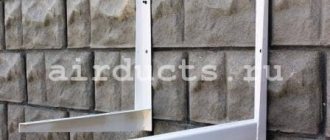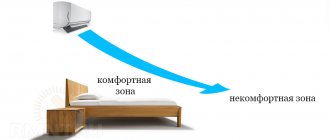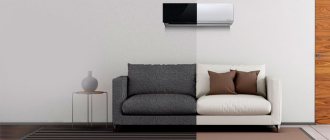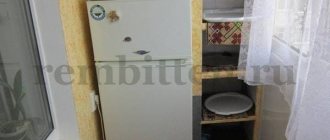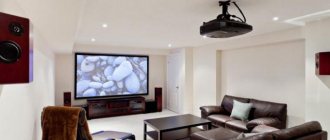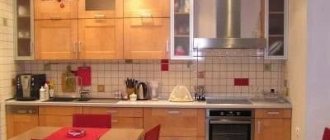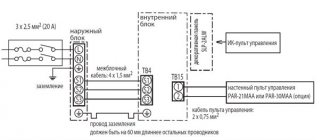The presence of a modern split system in an apartment allows you to create the most favorable living conditions: select the optimal temperature regime, adjust comfortable humidity, and filter the air. However, during the improvement process, you may encounter difficulties in installing an external unit on the facade, and an internal one in the room. Let's try to figure out how to install air conditioning on the balcony if there is no other way out.
What does a split system consist of?
Before turning to the installation features, let’s remember what parts the household appliance consists of. The air conditioner design consists of two separate blocks, one of which is mounted indoors, the second is fixed outside - on the facade of the house. The modules are connected to each other by a line of copper freon tubes and electrical wires.
The principle of operation of the split system
Cooling or heating of the air in a room is carried out by moving refrigerant through the tubes, which passes from the liquid phase to the gaseous phase (and vice versa), absorbing or giving off heat.
According to manufacturers' recommendations, the evaporator (indoor unit) is most often installed on the wall under the ceiling, where the air temperature reaches its maximum. Another important condition is installation next to the outer wall of the room, so that the distance to the remote module is minimal. The outer part is mounted on the facade, and the installation process is regulated by the requirements of SNiP 2.04.05-91* (as amended).
Reasons for installing blocks on the balcony
The realities of life are such that it is not always possible to follow the wishes of manufacturers. For example, there are legal grounds prohibiting the installation of an external module on the facade of a house:
- air conditioning equipment disrupts the appearance of the exterior of a residential or office building;
- the house is a historical or architectural monument;
- The external walls of the building are not suitable for the installation of heavy structures due to dilapidation, construction technology or other reasons.
In order not to use the facades, the remote air conditioner unit is placed on the balcony, and both open and glazed views are equally actively used.
Installation option inside a glazed structure
>
This way out has a number of advantages:
- easier and less expensive installation process;
- the housing is protected from external negative factors (hurricane wind, ice fragments falling from the roof);
- the distance between the parts of the air conditioner is reduced;
- simplifies equipment care - maintenance, cleaning, repair work.
There are also disadvantages to installing an air conditioner unit on a balcony, especially if glazing has already been done. You will have to take care of the forced removal of used air and always be prepared to turn off the equipment due to overheating (usually at +45 °C a protective auto-shutdown occurs). Two more troubles are associated with discomfort for residents: the bulky and heavy module body takes up a lot of space, and it produces quite loud noise, from which plastic double-glazed windows are unlikely to save.
Air conditioner installed on the balcony: solution or error
As mentioned above, any split system consists of two blocks and connecting parts. The external block contains the following elements:
- Compressor.
- Capacitor.
- Fan.
- Dehumidifier.
The indoor unit contains:
- Evaporator.
- Fan.
- Coarse and fine filters.
- Control Panel.
Connecting elements include pipe lines: electrical, freon, drainage. The external unit is the most massive part of the air conditioner. Its weight ranges from 30 to 80 kg, and its dimensions vary from 40 to 80 cm.
The overall dimensions depend on the power and functionality of the climate system. Size and weight are the main problem when deciding on installation. A mandatory rule for normal operation of the air conditioner is that the external unit must be installed in a place with sufficient volume and circulation of fresh air.
The optimal location for installing the external unit is the outer wall of the building. The unit can be installed in a convenient location on a street wall without special permission. But fixing the air conditioner to the wall is not always possible. This situation may arise for the following reasons:
- Restriction of local authorities on the placement of climate control equipment on the walls of buildings of historical or other value. Air conditioners can significantly spoil the appearance of streets and squares important for culture and tourism.
- Prohibition of the management company or the company that owns the building.
- Difficulty in installation due to the architectural features of the building.
- Safety hazard, high altitude or other significant circumstances (noise, vibration, condensation).
In such situations, the best option for installing a split system is to fix the external unit within the balcony or loggia. When planning modern apartment buildings, developers take into account trends and create special places on balconies and loggias for installing external air conditioning units. They are arranged in the form of special niches equipped with gratings, with special pipe lines for discharging condensate into a unified sewage system and supplying freon.
Installing an air conditioner on a glazed balcony should only be done in exceptional cases.
It is not recommended to install an air conditioner on a glassed-in loggia, but in cases where there are no other options, you can take advantage of this opportunity. It is important to adhere to a number of important rules and requirements.
Is it possible to install an air conditioner on a closed balcony?
In principle, the very installation of climate control equipment not on a permanent structure and in an enclosed space is already a violation of safety regulations. The recirculation process requires free access of air. If, nevertheless, the solution to installing an external air conditioner unit on the balcony remains the only possible one, take care of the conditions in which the equipment would operate without overloads and breakdowns.
Unprofessional installation can lead to equipment overheating and low efficiency
With an open-type balcony, everything is simple: the air conditioner has full access to fresh air, does not overheat, and therefore is able to work at full power. If the block is mounted inside a glazed structure, it is necessary to place it opposite the open sashes and make sure that they are not accidentally closed. If the air conditioner housing is installed on a parapet, a hole should be made in the casing to ensure recirculation.
>
Those wishing to secure equipment weighing 55-80 kg on the railing should be aware that SNiPs prohibit hanging any objects weighing more than 30 kg. Therefore, home craftsmen who have not received approval from management companies often install additional supports, weld brackets on the outside, install equipment at their own risk, and then pay fines. If it is possible to avoid hanging on a fence, then it is better to use it.
Common violation of generally accepted norms
One more point related to prohibitions. Balcony slabs often wear out faster than facades and even roofs. If the level of wear reaches 50%, then neither air conditioning, nor old heavy furniture, nor even double-glazed windows can be installed.
According to SNiP standards, the owner of the property is responsible for the balcony, as well as for the equipment placed on it. If safety standards are violated and someone else’s property or people are damaged as a result of falling equipment, fire or other trouble, the owner will be liable under a criminal article.
Acceptable installation on a solid wall
Thus, it is possible to install an air conditioner on a balcony if the installation does not contradict the standards and official approval has been obtained.
Unit Installation Instructions
Let's consider the most rational options for installing split systems, when the equipment cannot cause harm to either the apartment owners, passers-by, or neighbors. Work should be carried out taking into account the manufacturer’s recommendations, otherwise the equipment will quickly fail.
Option #1: installing an outdoor unit
Most often it is necessary to install an air conditioner on a glazed balcony of a cold or warm type. In the second case, in addition to the standard double-glazed structure, the balcony is insulated on all sides with heat-insulating material and lined with wooden clapboard or plastic. Thick walls with thermal insulation make it difficult to organize openings for air inlet or intake.
In order not to go against the standards and rules, installation should be done on the floor. It is better to use one of the corners so that a hole can be cut in the wall of the balcony to the size of the air conditioner. To prevent noise from operating equipment from penetrating into living spaces, the housing must be enclosed in a sealed box with an opening lid or door (for maintenance).
Transparent glass box
Thus, you can partially compensate for the disadvantages of installing an outdoor air conditioner unit on the balcony:
- a solid base, unlike brackets on the fence, ensures 100% reliability;
- fresh air circulates freely;
- due to the absence of one wall, the device does not overheat;
- the noise becomes almost inaudible;
- The usual temperature regime is maintained on the loggia or balcony.
The only inconvenience is the dimensions of the box, which will take up part of the usable area.
Installation is carried out in the following sequence:
- Prepare a place for installing an external remote unit. To do this, make a hole in the wall large enough to allow air to circulate freely. To place the body, it is better to weld (fasten to anchors) two U-shaped metal supports from the corners.
- Install the outdoor module on stands (it looks like it stands on 4 legs). Supports are necessary for shock absorption and additional air circulation.
- Mount the box. Boards, plywood sheets, galvanized steel, thick plastic or tempered glass are suitable for its manufacture. It is better to make the walls of the box multi-layered to create good sound insulation. The more airtight the casing, the more comfortable the apartment residents will feel.
- Holes are drilled in the wall with the adjacent room and in the box for connecting lines.
- They install freon tubes and electrical cables connecting the indoor and outdoor modules.
To prevent communications from being visible, they must be covered with a wide plastic cable channel. It is better to make the upper or side part of the box in the form of a hinged door that slides to the side or is completely removable so that, if necessary, repairs can be made or parts can be cleaned.
Hinged door for technical work
After testing the operation of the split system for 2-3 days, it will become clear how efficiently the equipment operates and whether additional noise insulation work is needed.
Option #2: installing an indoor unit
>
Sometimes it happens that an internal evaporation module is placed on the balcony, which should provide a comfortable microclimate directly in the living room - bedroom, living room, office or nursery. The reasons are varied: it does not meet the requirements of interior design, there is no free space, there is a risk of small children catching a cold, etc.
The optimal place for mounting the module is directly opposite the door, at a height of 1.8-2 m. If the air coming out from under the device’s blinds does not reach the room, the coolness will be felt more on the balcony. In addition, with such an arrangement of equipment, the door must always be open, otherwise the split system will again only cool the balcony.
There is no point in installing an evaporation unit on the end wall of a loggia, which is made of concrete or brick. The air will circulate freely inside the loggia, and only a small part of it will enter the room. Therefore, it will have to be somehow attached near the glazed part, consisting of glass/plastic or glass/aluminium.
Incorrect location - low efficiency
Stained glass structures will not withstand the weight of the module, and such an arrangement will not look aesthetically pleasing, so for the block it is necessary to create a suspended structure from brackets. One of the options is two suspensions made of a metal profile, the second is a perforated shelf.
Installation instructions:
- Suspensions are made from a metal profile, corner or strips, then they are mounted to the ceiling - a concrete slab.
- Install the evaporation module so that the blinds are directed towards the doors.
- Provide electrical power (install an outlet or organize cable laying from the room).
- Connect the fittings and cables leading to the outdoor unit.
- Check the operation of the equipment.
Please note that the temperature in the room will not correspond to the specified parameters, since the coverage area will increase due to the area of the balcony. Perhaps for the same reason you will have to buy an air conditioner of greater power than originally planned.
The only advantage of such an installation is the reduction in the distance from the internal module to the external unit located on the facade. The best option is to install the indoor air conditioner unit in a room with a balcony, and not outside it.
Choosing an installation location
Before choosing a location for installing an air conditioner, it is necessary to determine the heat losses of the room and the minimum costs to maintain the most comfortable temperature. It is generally accepted to install an air conditioner on a balcony or loggia, since here you can provide free access during installation, as well as in future maintenance by service specialists.
To maintain uninterrupted operation and long-term operation of the split system, it is necessary to install it technically competently.
There are two available options for installing an air conditioning system on a balcony:
- If the balcony is not glazed, it is allowed to install the external part of the equipment on it, since a sufficient supply of air from the external environment will have a beneficial effect on its functioning.
- It is forbidden to install the external part of the air conditioning system inside a glazed balcony, because a lack of air will cause rapid failure of the device.
Before installing an air conditioner on the balcony, it is necessary to take into account a number of technical features and manufacturers' requirements. Experts advise not to install equipment on an unprotected wall to avoid damage from hail, rain, and icicles. A more reliable installation location is a balcony. But, again, bad luck, it is impossible to install more than two external air conditioning systems on it.
Therefore, the split system is perfect for installation on a balcony; it consists of one external device and several internal ones. This installation will allow you not to burden the balcony and constantly maintain a comfortable air temperature in the apartment, especially in the summer, when the sun is especially active.
Installing a split system on the balcony with your own hands
When choosing an air conditioner, you don’t have to buy an expensive system and clutter up the balcony, where there is always not enough space. It is necessary to contact experienced specialists who will help you purchase a small, practical and reliable device.
Consequences of incorrect installation
There is a big mistake if you install an external air conditioning system inside the balcony. In an enclosed space, especially in summer, its outer part will quickly overheat and, reaching 40-45°C, turn off. This installation option will lead to rapid failure of the equipment.
Installation of a split system requires correct, step-by-step actions. It is common practice to install the external part of the air conditioning system outdoors, i.e. on an unglazed balcony or outside. With good ventilation, it will not overheat and will last a long time.
When installing a split system it is important:
- do not skimp on the length of the route;
- do not neglect the advice of experienced specialists;
- do not install the system inside a glazed balcony;
- install away from direct sunlight.
Installation details
In order to install the split system without errors, you must adhere to strict installation rules:
- The outer part of the system should be mounted on the facade or on the sides of the balcony, as well as on an unglazed loggia.
- Communications intended for air conditioning should be mounted in a plastic box and inside the balcony.
- Ensure the reliability and strength of the balcony and parapets, since the weight of the air conditioning system reaches over 60 kg.
If the device is installed on the front side of a balcony or loggia, the length of the drainage tube, metal pipes with refrigerant and electrical wiring increases. But the increase in communications does not affect the quality of the device’s operation, but significantly affects the monetary costs.
Installing an air conditioner on the facade of a house
Before you begin installation work, you need to make sure that the balcony parapets and walls on which the outdoor air conditioning unit will be mounted are strong. Also, it is necessary to take into account that when the air conditioner is operating, the outer part vibrates and can have a negative effect on the balcony, even to the point of collapse. Therefore, it is necessary to rationally think through all construction and installation work. If the balcony parapets and walls are old, their structure needs to be properly strengthened in order to avoid subsequent troubles.
The side part of the balcony parapet is ideal for installing an external air conditioning system. At the same time, the front part of the loggia or balcony will always have a well-groomed appearance, especially if containers with flowers or climbing ivy are attached to it.
Important! When installing an outdoor air conditioning unit, it is necessary to avoid the side exposed to direct sunlight or a completely bare wall. If it is not possible to install it in another place, it is necessary to install a volumetric canopy.
What mistakes should you avoid?
The biggest mistake is the wayward installation of the outdoor unit. If there are installation standards or prohibitions imposed by city authorities or the management company, you must first familiarize yourself with them. In case of violation, you will have to not only pay a fine, but also dismantle the equipment yourself.
Also, you should not install an outdoor unit in a glazed loggia with constantly closed or insufficiently open windows - the equipment will fail prematurely due to regular overheating. An incorrectly selected location for installing the indoor module will result in the split system running idle, cooling the air on the balcony and outside, rather than in the room.
If the air conditioner is installed to cool the loggia, then any wall will do
Often mistakes are made when arranging brackets for modules. If vibration occurs during operation, this must be provided for: install shock-absorbing pads, use only strong metal brackets that can support the weight of the unit. It is necessary to monitor the fasteners: constant vibration may cause the nuts to loosen over time.
Video tips for installing an air conditioner on a balcony
A box with thermal insulation is a rational way out of the situation:
An installation option in which the windows will always have to be kept open and the door closed:
What does it look like to attach an external block to a balcony railing:
>
There are indeed many restrictions for non-standard installation of a split system, so even before purchasing the equipment, it is better to ask whether it is possible to install an air conditioner on a balcony or loggia. If any regulations contradict your plans, look for another way out - to do this, consult with engineers or representatives of the management company.
YOU MAY ALSO BE INTERESTED
Installation inside the balcony
Residents of apartment buildings sometimes do not want to move the external unit outside the insulated and glazed balcony or loggia, because this complicates its installation and subsequent maintenance. Experts state that by installing an external air conditioner unit on a glassed-in balcony, users risk creating a steam room effect in the outdoor room in the summer heat - even by opening all the windows or double-glazed windows, you will not get rid of the accumulation of hot exhaust air.
The only way out of the deadlock is to install a window air conditioner, but here you will find other negative nuances: noise exposure, which will ruin your comfortable, cool rest. The verdict is simple: install the unit outside the insulated space, following all the recommendations we wrote earlier.
